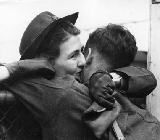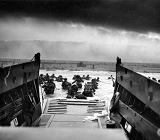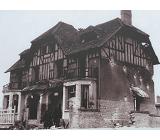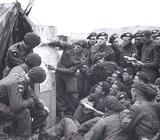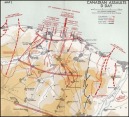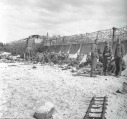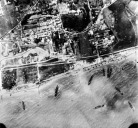The Juno Beach Landings
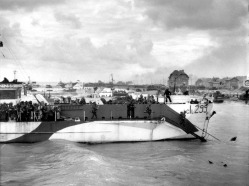
Canadian landings, Juno Beach, D-Day
The Canadian advance south on June 6th, 1944 was the furthest inland penetration made of all of the five Allied landing beaches on D-Day. Despite fierce resistance from the German defenders on the coast and delays owing to the huge traffic jams that developed on the beaches as more and more vehicles and men came ashore, the Canadians overcame their difficulties. However, although several impromptu solutions to unforeseen problems allowed the Canadian 3rd Infantry Division to push eight and a half miles (12km) south towards their main D-Day objective, the airfield at Carpiquet, they were still four and a half miles (8km) short when they dug in at nightfall on June 6th. As the advance south was resumed the following morning the Canadian forces were moving unknowingly into the waiting guns of the 12th SS Hitler Youth Panzer Division who had moved into the line opposite the Canadians after nightfall on June 6th. The SS counter-attacked and pushed the Canadian's back almost to their June 7th start line. The the front line was to advance little towards Carpiquet from it's D-Day position for almost the next five weeks.
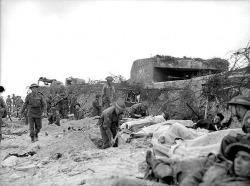
Canadian soldiers digging in, Juno Beach
On the afternoon and evening of June 7th 1944 at the Headquarters of SS Commandant Kurt Meyer at the Abbaye d'Ardenne, certain Canadian prisoners-of-war were executed by their SS captors. In a series of killings that would, by the time they stopped at the end of June, have claimed the lives of at least 139 Canadian and British POW's in SS captivity, these young Nazi soldiers ensured that the name of the 12th SS Panzer Division Hitler Jugend would always be associated with the brutality of the regime they so loyally followed.
The Battle Sites/Sights
Courseulles sur Mer
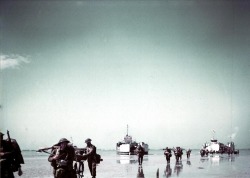
Canadian Troops Landing Nan White Sector
Courseulles sur Mer witnessed fierce fighting on the morning of June 6th, 1944 as the Winnipeg Rifles stormed ashore on the west bank of the river from which the town takes it's name. With the Regina Rifles on their left, landing on the east bank of the river Seulles. Although faced with what they had been told was a third rate German infantry division, lacking everything from motivation to transport, being in strong concrete defensive emplacements allowed the Germans to fight surprisingly effectively, their lack of transport giving them an otherwise absent tenaciousness as it removed the option of retreat. This led to the Canadians having to clear out each bunker, one at a time.
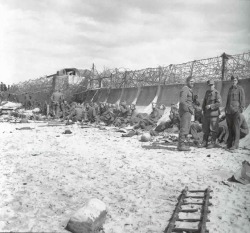
German Prisoners on Juno Beach
The evidence of this is visible scattered among the dunes, such as the Cosy Bunker, stormed by Lt Cosy leading B Company, the Royal Winnipeg Rifles, showing the evidence of where the Allied tank shells hit it, the British Royal Engineers AVRE Churchill tank, now standing at the exit from the beach that it was clearing when it was disabled on the morning of D-Day, the Duplex Drive Sherman tank that never made it to the beach on that fateful morning, finally salvaged from the sea bed and now standing on the seafront it once failed to reach, the German 50mm Anti tank gun still showing the holes where the Canadian shells pierced the armoured shield, and the Juno Beach Centre, the new Canadian museum, all lie along the shore of this Norman Seaside town.
Bernieres sur Mer
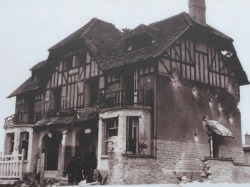
The 'Canadian House' on Juno Beach
It is here that the famous “Canadian House” can be found. Testament to the fighting on D-Day, this house featured in many film clips and photos taken of the D-Day landings in June of 1944. It stands much as it did on the morning of June 6th, 1944, only the bullet holes, evident in the many pictures, having been repaired. 200 meters east lies the German strong point in front of which the assault Battalion of the Queens Own Rifles of Canada came ashore that morning and lost so many of their number in subduing. It too bears the scars of the mornings fighting and one of the bunkers still has an Allied 37mm cannon shell that was fired at it embedded in its concrete walls, the concrete paving slabs lining the road nearby showing where the Canadian tanks advanced inland, the tank tracks gouging out their mark forever on the paving stones lining the road.
Les Hirondelles
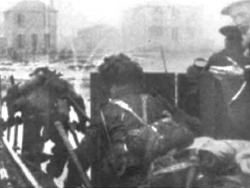
Canadian Troops landing, Les Hirondelles
The only surviving film taken on D-Day of a first-wave assault landing taking place was shot here on the morning of June 6th 1944. The shot, taken from the middle of a British Navy LCA, shows the front of the landing craft hitting the sand, the doors are kicked open and the ramp goes down, as the first few soldiers exit the craft, one of them carrying a ladder, a seafront villa can be seen in the background of the camera picture. Although often mistaken for the “Canadian House” at Bernieres sur Mer, this shot was actually filmed about a kilometer (two thirds of a mile) further east.
St Aubin sur Mer
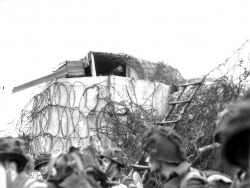
German Machine Gun Position Juno Beach
You will be shown here where the North Shore (New Brunswick) Regiments lead assault companies came ashore on the morning of June 6th, 1944. Accompanied by the tanks of the Fort Garry Horse Armoured Regiment, they faced stiff resistance from the German defenders who had fortified the seafront villas as well as installing concrete bunkers for their anti-tank guns. Beside one of these German Gun Bunkers is also a memorial that will remind you of the fact that not all the troops landed on Juno Beach were Canadian- over one third were British Troops, including the 48th Royal Marine Commandos. These troops suffered huge casualties immediately east along the coast as they fought to meet up with the 41st Royal Marine Commandos who landed at the western end of Sword Beach. One of these bunkers can be seen here in St Aubin, with it's anti tank gun still in place. Believed to be responsible for knocking out 6 Canandian tanks on the morning of D-Day, this gun, too, still shows the scars of the battle, the hole where the shot which finally put it out of action came through the gun shield permanently there for all to see.
The Advance inland and the SS counter-attack
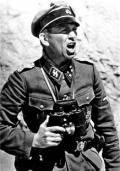
SS Colonel 'Panzer' Meyer
Although meant to be captured on June 6th, 1944, when the Canadian 3rd Infantry Division dug in on the night of June 6 th, they were still 4 miles (six kilometers) short of their objective. Wanting to make up for lost time, and believing that the German forces in front of them were negligible, the Canadian 9th Brigade pushed forward on the morning of June 7th. You will be driven along the road that the Canadians took, advancing rapidly southwards until they had reached the hamlet of Franqueville. From here, the lead Canadian tanks could see the airfield just eight hundred meters (half a mile)away. Unfortunately, the Canadian forces had underestimated the German resolve and in their haste that morning had failed to notice that the 12th SS Panzer Division was moving into the line in front of them.
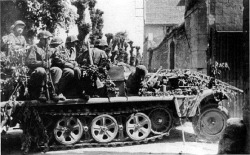
SS Troops driving into the Abbaye d'Ardenne
You will be shown the positions from where the teenage soldiers of this, the Hitler Youth SS Panzer Division, watched the Canadians advance across their front for more than three hours, some of these positions just yards from the advancing Canadian columns, before opening fire. Watching from the roof of the Chapel in the Abbaye d'Ardennes just two kilometers (less than one and a half miles) away, the leader of the SS troopers, Standartenfuhrer Kurt 'Panzer” Meyer waited until he judged the moment right, then sent his young troopers into the attack. Fighting with ruthless savagery that belied their youth, these SS child-soldiers pushed the 9th Canadian Brigade back almost to the positions they had held at night-fall the previous evening. As you will see on the monument to the 9th Brigade, the front line would not advance from this point, shortly to be christened “Hell's Corner”, for another month.
Abbaye d'Ardenne
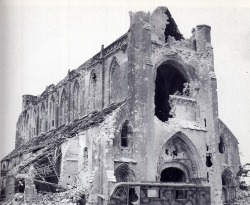
The Chapel, Abbaye d'Ardenne after the battle
Here you can visit the site of the 12 Century Abbey that from the evening of June 6th until the start of July 1944 housed the headquarters of the 25th SS Panzer Grenadier Regiment of the 12 SS Panzer Division. It was to this place that Canadian prisoners, captured during the German counter-attack of June 7th, were brought. You will be shown the stables where the prisoners were initially held before being brought out to a sheltered rear garden for interrogation. When the Canadians had refused to talk they were executed one at a time by their SS captors. There is some dispute as to how many soldiers were executed in this manner but it is generally agreed that there were about 18 soldiers executed in the Abbaye d'Ardenne. Memorials to these unfortunate soldiers can be found in several locations throughout the Juno beach area as there were similar massacres of Allied POW's in several other locations, the worst being in the grounds of the Chateau d'Audrieu where the divisional Headquarters of the 12th SS Panzer Division was located. Here, over seventy Canadian and British Prisoners of War were executed by the 12th SS Panzer Division. Other similar executions of American Paratroopers were also carried out by the 17th SS Panzer Grenadier Division south of Carentan.
